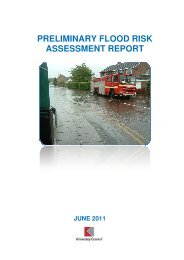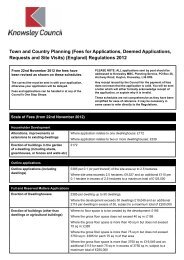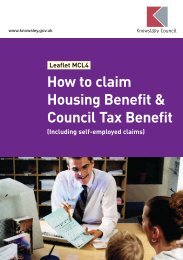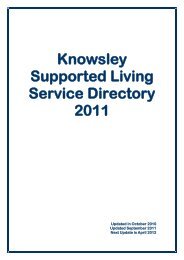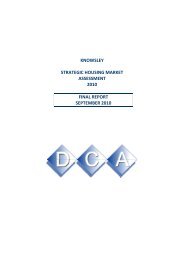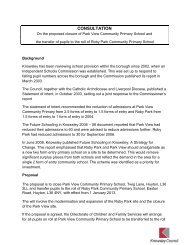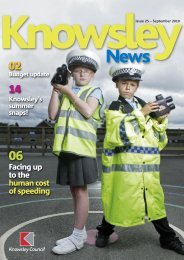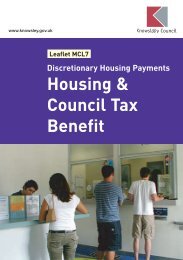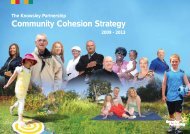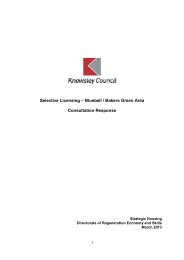Knowsley Replacement Unitary Development Plan - Knowsley Council
Knowsley Replacement Unitary Development Plan - Knowsley Council
Knowsley Replacement Unitary Development Plan - Knowsley Council
Create successful ePaper yourself
Turn your PDF publications into a flip-book with our unique Google optimized e-Paper software.
URBAN GREENSPACE, SPORT AND RECREATION<br />
URBAN GREENSPACE, SPORT AND RECREATION<br />
EXPLANATION OS2<br />
THE BENEFITS OF URBAN GREENSPACE<br />
10.7<br />
The <strong>Council</strong> has identified a need to continue to<br />
improve the quality of urban greenspaces in<br />
<strong>Knowsley</strong>, to ensure that they contribute in different<br />
ways to community needs. Urban greenspaces vary<br />
widely in type (see figure 10.1), size and value to the<br />
community, and smaller sites may not be identified<br />
specifically on the Proposals Map. New development<br />
within or affecting greenspaces (irrespective of<br />
whether the quantitative standards in policy OS3 and<br />
OS4 are met) should aim to protect or enhance their<br />
qualities, which can include the following:<br />
• Visual amenity<br />
• The provision of open vistas within the<br />
urban area;<br />
• Increasing tree coverage by providing suitable<br />
sites for tree planting;<br />
• The provision of visual screening for<br />
commercial uses;<br />
• The framing of transport corridors, providing<br />
a welcoming and attractive gateway to urban<br />
areas; and<br />
• Contribution to the landscape and identity of<br />
the surrounding area.<br />
• Urban quality and residential amenity<br />
• Supporting regeneration and improving<br />
quality of life for communities by providing<br />
visually attractive green spaces close to<br />
where people live;<br />
• The provision of buffers between residential<br />
and commercial areas, and alongside<br />
roads, thereby reducing noise and pollution<br />
for residents.<br />
• Wildlife value and environmental benefits<br />
• The provision of natural landforms, havens<br />
and habitats for flora and fauna and<br />
wildlife corridors;<br />
• Sites of geological and/or geomorphological<br />
interest;<br />
• Opportunities for environmental education;<br />
and<br />
• Accommodation of watercourses, water<br />
features and emergency flood storage areas.<br />
• Cultural and Community Value<br />
• Accommodation of historic or<br />
archaeological remains;<br />
• Where a site has cultural or historic<br />
significance for the community; and<br />
• The provision of sites for fairs and other,<br />
community events.<br />
• Recreational and health benefits<br />
• Providing opportunities for informal and<br />
formal recreation within sites;<br />
• Encouraging people to walk or cycle along<br />
green corridors; and<br />
• The provision of sites for allotments<br />
encourages exercise and healthy eating.<br />
• Strategic benefits<br />
• Defining and separating urban areas;<br />
• Providing linkages between town and country<br />
e.g. green corridors; and<br />
• Links to, and between, open spaces.<br />
GUIDELINES FOR DEVELOPMENT<br />
AFFECTING GREENSPACES<br />
10.8<br />
Although it is important to conserve greenspaces that<br />
make an important contribution to the community<br />
and the environment, the <strong>Council</strong> will not seek to<br />
operate a wholesale presumption against the<br />
development of urban greenspace. New development<br />
will be allowed where it satisfies any of the criteria<br />
under the second part of the policy.<br />
10.9<br />
It may not always be appropriate for replacement<br />
facilities to be of exactly the same scale or nature as<br />
those that may be lost, but they should always be of<br />
the same or greater value to the community and be<br />
“fit for purpose”. For example, the replacement of a<br />
number of playing pitches with an artificial turf pitch<br />
may provide more games to be played per year or<br />
season, but it may not allow a sunday league to play<br />
their games at the same time, or allow players to<br />
make challenges due to the abrasive surface.<br />
10.10<br />
Adjacent urban greenspaces can link together to<br />
form urban greenspace systems, sometimes known<br />
as green corridors, providing a greater overall benefit<br />
than the spaces can provide individually. The spaces<br />
may be separated by small gaps such as roads,<br />
railways or small pieces of land, but are still visually<br />
linked. As well as providing the benefits of individual<br />
open spaces, they can provide attractive, safe, traffic<br />
free access to other open spaces and even the<br />
countryside, can perform strategic functions and act<br />
as wildlife corridors. Many greenspaces also perform<br />
a valuable function providing habitats and existing or<br />
potential planted areas as part of the Mersey Forest<br />
initiative described in policy DQ4.<br />
10.11<br />
Wherever possible these systems should be<br />
expanded, with footpaths and cycle paths linking to<br />
and through them. In some cases access may be<br />
restricted for reasons of community safety and<br />
security, however non-publicly accessible spaces can<br />
still perform an important role in providing ecological<br />
and visual links, and care should be taken to ensure<br />
that such roles continue. The <strong>Council</strong> may identify<br />
existing and/or potential new urban greenspace<br />
systems in a Supplementary <strong>Plan</strong>ning Document.<br />
An example of an open space system is the series of<br />
open spaces along the Alt Valley, particularly along<br />
Seth Powell Way.<br />
POLICY LINKS<br />
Policy T7<br />
"New development and walking and cycling routes"<br />
Policy OS3<br />
“Quantitative Standards - Public Open Space for<br />
General Amenity Use, allotments and Children’s<br />
Play”<br />
Policy OS4<br />
“Protection of Playing Pitches and Other Formal<br />
Sporting Facilities”<br />
POLICY OS3:<br />
QUANTITATIVE STANDARDS - PUBLIC OPEN<br />
SPACE FOR GENERAL AMENITY USE,<br />
ALLOTMENTS AND CHILDRENS PLAY<br />
1. When considering planning applications, the<br />
following standards for the provision of public<br />
open spaces will be applied as a minimum (not<br />
including land formally laid out as playing<br />
pitches and other sporting facilities):<br />
a) No Substantial Residential Area should<br />
have less than 0.5 hectares per thousand<br />
residents for general amenity use, 0.05<br />
hectares for allotments and 0.2 hectares<br />
for children's play; and<br />
b) All households should have access to<br />
amenity greenspace, allotments and<br />
children’s play space within a catchment<br />
distance that is appropriate for the users.<br />
2. In any part of the Borough where provision<br />
falls below the standards set in 1) above, the<br />
loss by development of any greenspace<br />
(irrespective of its current use) which would be<br />
suitable in terms of its size, location and<br />
character, to help to make good the deficiency<br />
will not be permitted.<br />
114<br />
KNOWSLEY REPLACEMENT UNITARY DEVELOPMENT PLAN: Adopted June 2006<br />
KNOWSLEY REPLACEMENT UNITARY DEVELOPMENT PLAN: Adopted June 2006<br />
115



